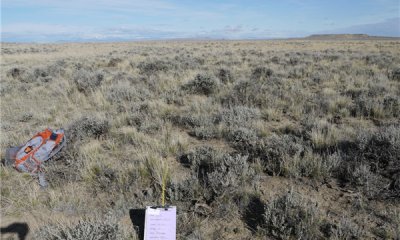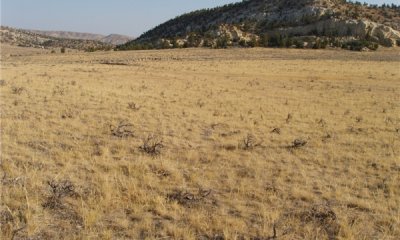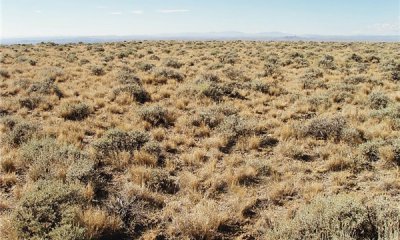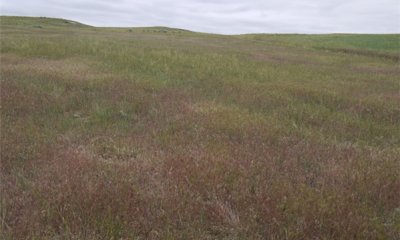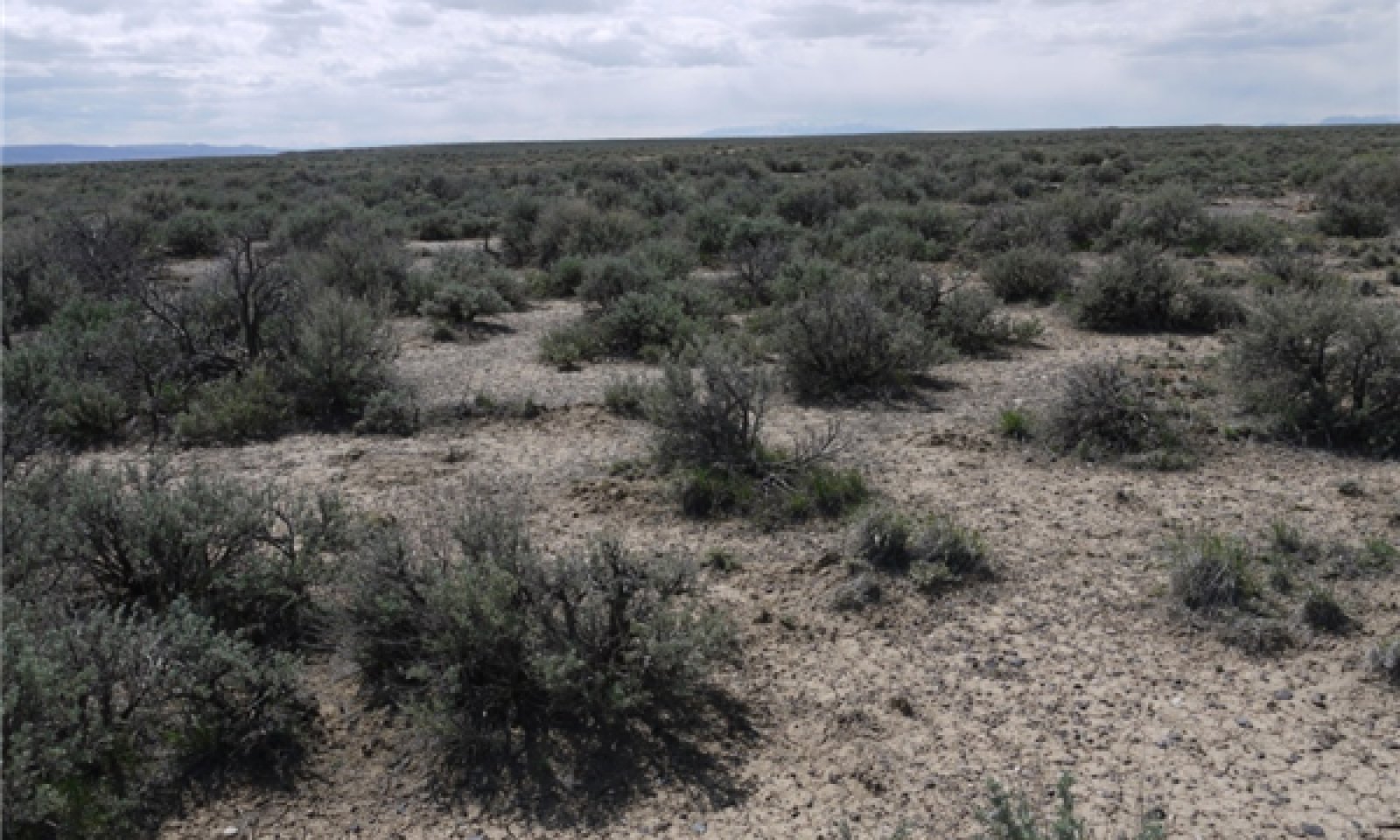
Loamy Calcareous (LyCa) Big Horn Basin Rim
Scenario model
Current ecosystem state
Select a state
Management practices/drivers
Select a transition or restoration pathway
- Transition T1A More details
- Transition T1B More details
- Transition T1C More details
- Transition T1D More details
- Transition T2A More details
- Transition T2B More details
- Transition T3A More details
- Transition T3B More details
- Transition T4A More details
- Transition T4B More details
- Transition T5A More details
- Restoration pathway R6A More details
- Transition T7A More details
-
No transition or restoration pathway between the selected states has been described
Target ecosystem state
Select a state
State 1
Reference



Description
The reference state is characterized by the dominance of Wyoming big sagebrush, at 15% or less composition by weight, with Bluebunch wheatgrass, at 40% or less composition by weight. But with these two dominant species, the site holds a healthy mix of rhizomatous wheatgrass, Western and Thickspike, as well as Indian ricegrass, Needleandthread, and to a minor extent sod-formers such as Threadleaf sedge and Blue grama.
In refining the ecological site characteristics and the reference state, the reference was made to soils that classified as fine-loamy in comparison to coarse loamy soil texture classification and how the plant communities varied. The initial thought was that these two classifications needed to be separated. As a review of the specific locations where this was visible on the landscape, a phenomenon on the landscape was documented showing a plant community shift as soil surface structure changes.
A rangeland trend plot study site has two differing plant communities occurring alternating along a transect. Both communities are within the reference state, but at separate ends of the plant composition spectrum. One community was expressing a higher occurrence of Indian ricegrass, Threadleaf sedge and Blue grama (coarse-loamy) while the second plant community was expressing a higher composition of Western wheatgrass and Needleandthread (fine-loamy). The transitions appeared to be abrupt in nature between these plant communities.
Soils were reviewed, and found no apparent difference in the soil profile excluding the surface horizon or cap. Under the Indian ricegrass community, the soil surface has granular structure, where the Western wheatgrass community soils have a thin vesicular crust or platy structure. Beyond this minimal surface difference there appeared to be no difference in soil structure, texture, or classification.
The lack of distinction limits the ability to separate the two communities into individual ecological sites or communities, but the range of plant composition will capture this characteristic within the plant community tables. The photo documenting the occurrence of this phenomenon is in the photo for Community 1.2, demonstrates these two plant communities as they co-exist on the landscape.
Submodel
Description
During the late 1960’s and throughout current time, there have been large areas of sagebrush control completed using techniques such as aerial applied chemicals, burning, mowing, spike treatments and other land based hand treatments. Many of the treatments today are done on a smaller scale, mosaic pattern to better benefit wildlife, however, some of the older style treatments were used to eradicate large areas of sagebrush in one prescription.
Prescribed grazing or possibly long-term prescribed grazing, will allow recovery of this plant community to a community similar to the Reference state if there is relict or nearby seed source for sagebrush species. The process may take several years or may need mechanical, localized plantings to assist the process. The use of drought recovery plans are essential to the success of re-introducing shrub species once they are removed due to the already altered hydrologic function of the site. Again, the process will be slow and the probability of recovering to the 1.1 community is marginal, but there is the ability to recover the 1.2 state with time and possibly minor mechanical improvements.
As a consequence, there are large acreages of landscape that have lost all sagebrush cover and may never recover, unless seeding or transplants are completed. The plant community, and state, created by this loss of sagebrush is dominated by the Perennial bunchgrasses and forbs as the only cover. The variability of this plant community is a reflection of the treatment that occurred and the state or condition of the landscape prior to the treatment.
Submodel
Description
If continued pressure or disturbance occurs on the vulnerable community within the reference state (State 1), it can be forced into the Sagebrush/Bare Ground State. This state name is somewhat misleading in the perception considering that bare ground may only increase slightly and in many cases there is no change or a light decrease in cover by sagebrush. Over time, drought or grazing pressures on this state will eventually drive the sagebrush/shrub canopy out or decrease the health and vigor of the plant to a non-sustainable level. The herbaceous plant production may remain only slightly decreased, but the thriving species usually occur under the canopy of Wyoming Big sagebrush or similar shrub species (rabbitbrush) and within the protection of Prickly pear cactus.
Brush management, followed by prescribed grazing, may return this plant community to a similar or near Reference Plant Community. If prescribed fire is used as a means to reduce or remove the shrubs, sufficient fine fuels will need to be present. This may require deferment from grazing prior to treatment. Post management is critical to ensure success. This can range from two or more years of rest to partial growing season deferment, depending on the condition of the understory at the time of treatment and the growing conditions following treatment. In the case of an intense wildfire that occurs when desirable plants are not completely dormant, the length of time required to reach a community within the Reference State may be increased and seeding of natives is recommended.
A site was identified that was dominated by Wyoming big sagebrush with an understory of bottlebrush squirreltail, Bluebunch wheatgrass, Sandberg bluegrass, and annual forbs. Production was low; Wyoming big sagebrush was at approximately 25% canopy. The site was selected for a trial sagebrush treatment by Bureau of Land Management (BLM), one area was treated with small patch burns and several other areas were treated with a mowing prescription, at varying times of year and heights. The canopy of herbaceous cover for the burned site is delayed and very slow to respond, where the canopy under the mowing treatments responded within a growing season. Transects established on the location were dominated by Bottlebrush squirreltail, and minimal other species. The sites continue to be monitored. It is the consensus, that the timing and the climate for that year was optimal for the residual seed bank of Bottlebrush squirreltail. So the mowing treatment acted as a seed dispersal process allowing the plant species to flourish.
Submodel
State 4
Sod Bound
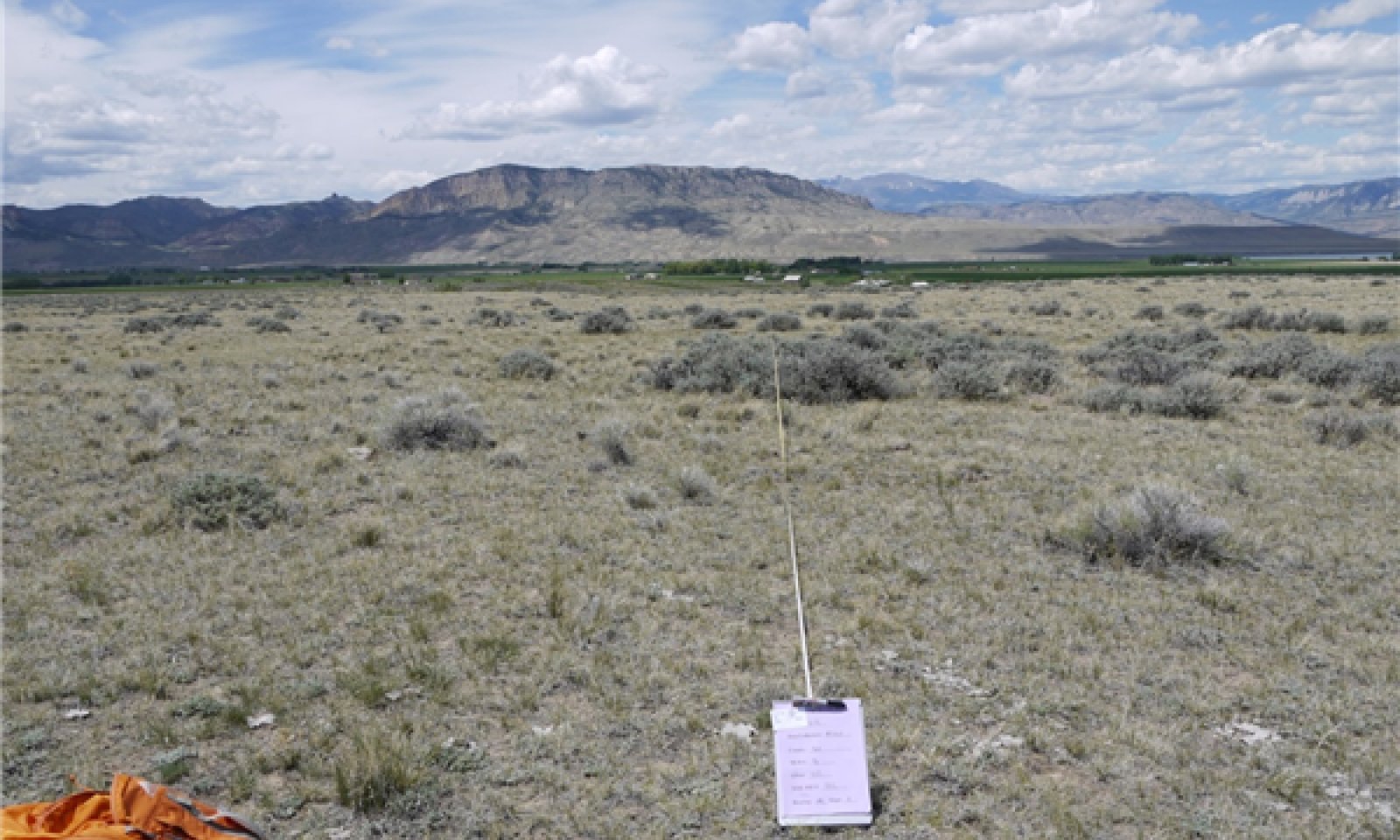


Description
Blue grama and Threadleaf sedge are sod-forming species that exist as a component of the perennial vegetation naturally (in reference communities) in the ecological site. The general tendency of these species is to increase under grazing pressure, becoming dominant. The species that gains dominance appears to be dependent on which species is more prevalent in the community before the negative pressures are applied.
Submodel
State 5
Invaded



Description
Invasive plant species are a permanent concern with rangelands and management. Each year new species are discovered and will alter this section as they are. Currently within the Big Horn Basin there are several varieties of thistles, knapweeds, milkweeds, mustards and others that create a management issue for livestock and ecology. In areas where there has been a disturbance, natural or man-made, these species can gain a place in the landscape and are difficult to impossible to eradicate. Because of this it becomes a battle to maintain control with annual or prolonged management of the weed species, and preventing further shifts or changes to the native composition.
Submodel
Description
Currently within the Big Horn Basin, Cheatgrass or Downy brome (Bromus tectorum) is the invasive annual grass species that has been a concern for management. Although there are many other species of forbs that are becoming monoculture stands, Cheatgrass is the species that is taking large acres of land quickly in this region.
Knapweed, namely spotted, also became dominate in large dense stands and produces an even more challenging set of management issues. As more species are found within the Big Horn Basin or as other species become more prevalent in large scale communities, this section will need to shift to meet the concerns of these species. But with the persistence of Cheatgrass and the lack of a successful control agent at this time, it is not conceivable that Cheatgrass will ever go away or become less of a management challenge.
This state is characterized by the lack of all or most of the shrub component of this site. Whether drought or wildfire has removed this component, the competitive nature of annuals, the altered fire regime created by Cheatgrass, and the effect of the loss of the shrub component itself creates an environment that does not support the propagation of new shrubs.
Submodel
Description
The Degraded state could be drafted as a stand-alone box within the state and transition model diagram. No matter what state a site originally is ranked in, once the site is mechanically disturbed, or suffers a catastrophic or significant natural disaster that alters the soil properties (erosional, depositional, hydrological or chemical), the site potential is altered. To consider this as an alternate ecological site would not be unreasonable. In some cases (site by site consideration), a re-correlation of a location may be the best solution. But in many cases, the site has not been altered out of the current site, but the potential has shifted enough that it is no longer truly comparable to the reference community. So a dynamic state was captured to detail the altered communities that exist on the landscape.
Submodel
Mechanism
Extensive Brush Management or Fire with Drought, creates a shift in the hydrology of the site preventing the re-establishment of Wyoming big sagebrush on the site without extensive management changes. This transition has been seen to occur with sites that were treated with chemicals aerially in the late 1960’s, and in areas where wildfires burned hot or were fired with a period of extended drought inhibiting the seed bank or preventing the establishment of seedlings into the area.
Mechanism
Frequent and severe grazing plus no fire on soils with limited soluble salts, will convert the plant community to the Big Sagebrush/Bare Ground Plant Community. The probability of this occurring is high. This is especially evident on areas with historically higher precipitation and the sagebrush stand is not adversely impacted by drought or heavy browsing.
Mechanism
Frequent and severe grazing (yearlong grazing) plus wildfire or brush control, will convert the plant community to the Blue Grama Sod Plant Community. The probability of this occurring is high, especially if the sagebrush stand has been severely affected by drought or heavy use or has been removed altogether.
Mechanism
Frequent/Severe Grazing, Fire, Drought, Disturbance with introduction of seed source, will allow this plant community and any of the states to shift to an Annual invaders/Wyoming Sagebrush Plant community or Annual Grass Plant Community. The risk for this transition or threshold to be crossed is high, especially with the continued increase of invaders in high traffic areas and the persistence of drought which will open the plant community and allow for the establishment of the seed source.
Mechanism
Frequent or Severe Grazing, Drought – A shift from the cool season perennial bunchgrasses to Threadleaf sedge or Blue grama sod can be driven by extended drought or drought like conditions brought on by high winds, lack of snow catch due to loss of sagebrush canopy and through the effects of compaction and plant reduction caused by frequent or severe grazing. As the roots and vigor of the mid-stature bunchgrasses and rhizomatous wheatgrasses that typically dominate this site are reduced with increased climatic or herbivorous pressure, the ability for water to infiltrate and to withstand dwindles, opening the canopy for the sod-formers to dominate. The sod-formers can catch more of the moisture as it is available and to utilize the quick moving storms more efficiently than the deeper rooted more spaced bunchgrasses.
Mechanism
Frequent or Severe Grazing, Wildfire, Disturbance - The chance of wildfire is reduced with the loss of the fuels from sagebrush to help carry across large areas, however, in favorable production years areas can produce enough fine fuels to carry a wildfire which in turn opens the canopy and provides a niche for annual invaders such as Cheatgrass and knapweeds to take hold. If the seed source is available, fire is a well-known avenue to provide the conditions for annuals to flourish, as well as general disturbance whether from herbivores or man-induced. Once the seed source gains a place in the community, it is extremely difficult to manage and may not be feasible or possible to completely remove the invaders.
Mechanism
A combination of Long term prescribed grazing or non-use in combination with Brush management, followed by a disturbance or frequent and severe grazing or drought will convert the plant community to the Perennial Grasses/Annual Invaders/Big Sagebrush State or could possibly push it to the Blue Grama Sod Plant Community if the source is present.
Mechanism
Drought, Wildfire or Brush management, followed by frequent and severe grazing, will convert the plant community to the Annual Grass State if the disturbance is extensive enough and the threat of invasives is present in the area. Or, could possibly push it to the Blue Grama Sod Plant Community if the source is present.
Mechanism
Drought, Frequent or severe grazing, Disturbance – Drought as the only factor or drought with grazing intensity together can work to weaken or kill Wyoming big sagebrush on the landscape, and once it has declined or been removed from an area it is not known if or how long it will take for it to come back without cultural methods, which do not carry a reliable success rate. Blue grama and Threadleaf sedge have been seen to die back or die out with prolonged drought opening the canopy and the community’s vulnerability to invasive species. Disturbance by mechancial means or human activities that break the root masses or disturb the soil surface open this closed community to potential invasive species, especially when there is a readily available seed source for those invasive species.
Mechanism
Drought, Frequent or severe grazing - With the loss of structure height on the landscape as Wyoming big sagebrush recedes in this community, it intensifies the drought effect on the plants and will assist in opening more bare ground and make the community vulnerable to invasion by annuals and invasive species.
Mechanism
Fire (wild), Frequent or severe grazing, Drought – The threshold species in this system is the Wyoming big sagebrush, which is providing a niche for the perennial natives to persist in the landscape. Once the sagebrush is affected by the altered (shortened) fire frequency of this state due to the invasive species (primarily cheatgrass), or with the persistence of drought and frequent or severe grazing, then this niche begins to fade or can be taken rather suddenly in the case of a fire. Once the sagebrush has died back or has been removed by fire it is very difficult to return and may require several years (25 years or greater) to return or may not without outside assistance.
Mechanism
Integrated Pest Management, with Seeding the site to a native mixture - Success is not known to have occurred, and is rated to be low and highly variable for the rate of control of most species. Cheatgrass and knapweeds are two of the most invasive species for many of these sites but there are many others, for example, Halogeton, that can dominate these sites. It is a consensus that the site can be brought to an at-risk community within the reference state, but that it is not possible to reach the reference community condition once annuals have established on a site.
Relevant conservation practices
| Practice | External resources |
|---|---|
|
Critical Area Planting |
|
|
Range Planting |
|
|
Heavy Use Area Protection |
|
|
Integrated Pest Management (IPM) |
|
|
Native Plant Community Restoration and Management |
|
|
Prescribed Grazing |
|
|
Fuel Break |
|
|
Invasive Plant Species Control |
|
|
Monitoring and Evaluation |
Model keys
Briefcase
Add ecological sites and Major Land Resource Areas to your briefcase by clicking on the briefcase (![]() ) icon wherever it occurs. Drag and drop items to reorder. Cookies are used to store briefcase items between browsing sessions. Because of this, the number of items that can be added to your briefcase is limited, and briefcase items added on one device and browser cannot be accessed from another device or browser. Users who do not wish to place cookies on their devices should not use the briefcase tool. Briefcase cookies serve no other purpose than described here and are deleted whenever browsing history is cleared.
) icon wherever it occurs. Drag and drop items to reorder. Cookies are used to store briefcase items between browsing sessions. Because of this, the number of items that can be added to your briefcase is limited, and briefcase items added on one device and browser cannot be accessed from another device or browser. Users who do not wish to place cookies on their devices should not use the briefcase tool. Briefcase cookies serve no other purpose than described here and are deleted whenever browsing history is cleared.
Ecological sites
Major Land Resource Areas
The Ecosystem Dynamics Interpretive Tool is an information system framework developed by the USDA-ARS Jornada Experimental Range, USDA Natural Resources Conservation Service, and New Mexico State University.
